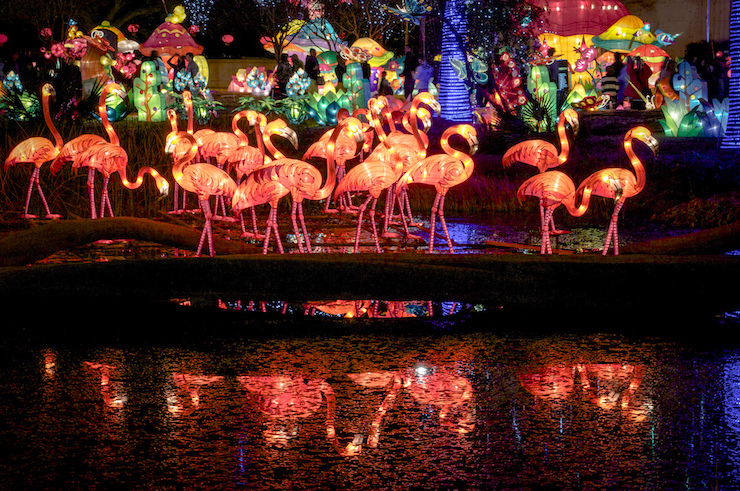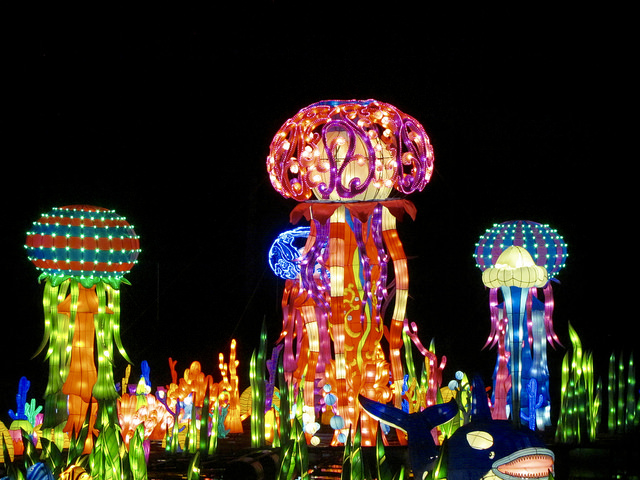After I took that spill on a hill at dusk into a pile of Mackinac Island horse manure some years back, I was afraid to climb back on my bike. But when we moved into this neighborhood carved from the Everglades, I agreed to join my husband on various wild adventures, some of which involved bikes. So early one Sunday evening we pedaled (I mostly wobbled) the three miles or so to Burt Aaronson South County Regional Park. It meant crossing a four-lane highway, and even though there was minimal traffic, the pavement looked mighty hard.
When we got to the entrance near the Osprey Point Golf Course, we had to dodge a stream of cars coming from the opposite direction and heading into the park. We figured out they were on their way to a “Chinese Lantern Festival” at the Sunset Cove Amphitheater. It had already been going for a month, with two weeks yet to go. How could so many people be so interested in Chinese lanterns? This, however, was not the night to go exploring. I needed to leave the premises before I tumbled into a car or one ran into me. Plus we didn’t have lights on our bikes, and the sun was going down.
Once safe at home, I did a web search. These weren’t just those sky lanterns we saw floating over the lake prior to a Fourth of July fireworks show. Nor were they a display of tree-swaying, paper-covered lamps. I discovered Chinese lanterns are a really big deal, and I was thrilled to have found somewhere to take my niece and great-nephew when they came from Michigan the following week.
The festival, the first in our area, was sponsored by Hanart Culture, which takes its name from “han,” the largest nationality in China, and refers back to the Han Dynasty, considered a golden age in Chinese history. The second part “art,” refers to all kinds of art styles, including kung fu, martial arts, and acrobatics. The company’s purpose is to bring Chinese art and culture to the world.
Our first stop on the night we visited was the dinosaur empire where life-sized replicas moved and roared. My great-nephew was able to ride one like a box store pony. I wondered what dinosaurs had to do with this event and later discovered that the Chinese Lantern Festival originated in the city of Zigong, also known as the “Lantern Town in the South Kingdom.” A “dinosaur quarry” was discovered there in the 1980s, and in 1987 the Zigong Dinosaur Museum, the first specialized dinosaur museum in Asia, opened.
We enjoyed a spectacular martial arts and kung fu performance. Afterwards, the great-nephew participated in a short group lesson on stage. We visited the craft tent where we saw art demonstrations of techniques such as straw weaving, paper cutting, dough modeling, sugar drawing, and Chinese knotting. A clay sculptor molded the faces and torsos of a couple posing for him, dressing the sculptures similar to his subjects.
When the sun set, the main art indeed became magic. The theme of the festival was “The Wild,” and Zigong artisans had spent nearly 30,000 hours assembling 800 colorful lanterns depicting animals from every continent. A herd of alligators and a flock of flamingos greeted us on the hill by the lake. We might have expected them, but as we walked on, it seemed like the world came together on that 15 acres, a sense accentuated by the various languages we heard spoken around us as a result of living in a multicultural area of South Florida.
The artisans used rayon, satin, ceramic, steel wires, and porcelain to construct the lanterns. They used thousands of low-watt LED bulbs to illuminate them, and several displays were even animated. Others, like a reef replica and a herd of hippos, were set directly in the lake. Tigers roared, and birds chittered. My father-in-law raised peafowl, so I especially appreciated the strutting peacock, its bright colors the result of small medicine bottles filled with colored pigment.
A yellowish-and-brownish-striped grasshopper gazed at me with its big black, green-ringed compound eyes. Or maybe it was a dragonfly. Or maybe it was a new creation. At any rate, fragments of Mary Oliver’s poem “A Summer Day” began to wisp around my head.
Who made the world?
Who made the swan, and the black bear?
Who made the grasshopper?
This grasshopper, I mean . . .
who is gazing around with her enormous and complicated eyes.
— Mary Oliver (read the rest of the poem)
And to think I would have missed it all if I’d chosen to play it safe and refused to wobble out on my bike that Sunday evening. I would have missed the opportunity to appreciate the passion of so many people dedicated to plying their wild art and connecting cultures through it. I would have missed an answer to Mary Oliver’s question.
Tell me, what is it you plan to do
with your one wild and precious life?
Featured photo by A. Vandalay, Creative Commons, via Flickr. Post and photos by Sandra Heska King.
__________________________

“I require all our incoming poetry students—in the MFA I direct—to buy and read this book.”
—Jeanetta Calhoun Mish
- 50 States of Generosity: Rhode Island - June 2, 2025
- 50 States of Generosity: Iowa - April 7, 2025
- 50 States of Generosity: Montana - January 27, 2025




Donna Falcone says
I’m so happy for you, that you wobbled out and stumbled upon such a treasure! AND, I’m so happy for all of us, that you shared it so beautifully here. I lit up inside (no pun intended, but not bad) at the thought of the hippo and reef replicas set out in the water. Oh, the colors! The shimmery, reflecting colors!
Sandra Heska King says
Your comment lights me up inside. 😉
You would have loved it, Donna. It really was stunning. And you would have been so fascinated with the goings on in the craft tent.
Bethany Rohde says
You faced your fears, ventured out, and what came of it? You got to bring your family—and now us—close up to a fascinating display of color and culture. Thank you!
Sandra Heska King says
It makes me wonder what I’ve missed because I said no to a little adventure. 🙂
Megan Willome says
It’s all about “this grasshopper,” isn’t it?
I knew nothing about this festival, Sandy, or the history behind it. Thanks so much!
Sandra Heska King says
“This grasshopper.” Yes. I hope you get to experience one of these festivals, Megan. With lots of lanterns. Some I’ve seen don’t have nearly as many as this one did.
Sandra Heska King says
“This grasshopper.” Yes. I hope you get to experience one of these festivals, Megan. With lots of lanterns. Some I’ve seen don’t have nearly as many as this one did.
I liked what the Hanart lady said at the very end of the video: “Sometimes our politics differ, but I think our day-to-day lives are very surprisingly the same.”
If only we could remember that.
Laurie Klein says
Ohh, spectacular! What riches evolved from a wobble. A feast for these (currently) housebound senses.
Thank you for braving the trip and reporting back with such candid verve and delicacy.
“it seemed like the world came together …”
Sandra Heska King says
Something weird is happening. I’m pretty sure I replied yesterday, Laurie. I think the last part of my second response to Megan was meant for you. Anyway… thanks for coming along with me. We could all use a little more coming together.
Marilyn says
Thank you for introducing this to me. I knew absolutely nothing about it. The photos are fabulous i would call this an artist’s date, don’t you agree? 🙂
Sandra Heska King says
Oh, I think you’re right, Marilyn! High five. And I did wander off by myself for a while. Julia would approve, I think.
Lynn D. Morrissey says
Sandy, I love this, and when I read it at first on *your* site, admittedly, I did a head turn (or two!) Herds of alligators!? How on earth is she going to handle that and risk losing her one and precious and wild life, I thought?! Yikes! Oh . . . so these are alligator lanterns! I loved seeing all these glowing creatures…. so beautiful. And it all reminds me of the big Chinese Lantern Festival at the Missouri Botanical Garden (I think perhaps one our country’s largest such festivals). Our daughter Sheridan interned as a photographer there and had the joy of capturing photos of creatures and figures lit from within. And isn’t that what life and poetry are about, too–being lit from within, sharing our light and our fire to warm our lives and others’ lives too? You certainly always warm my heart, dear Sandy!
Love
Lynn
Sandra Heska King says
So first you made me laugh. “How on earth is she going to handle that and risk losing her one and precious and wild life, I thought?!”
Then you made me think. “And isn’t that what life and poetry are about, too–being lit from within . . .”
And then, of course, I had to go find out more about MBG’s festival. That must be like entering China itself. I’ll bet Sheridan had so much fun. I hope maybe someday we can visit.
I love when you comment, Lynn. Always so fun and encouraging. And I always learn something new.
Lynn D. Morrissey says
Oh you are just the best, Sandy. Love you and your beautiful writing!! And Sheridan will appreciate that you checked out Mobot (as we call it). I think it may have the largest or 2nd largest Japanese Garden in America. It’s quite lovely. The Chinese Garden is smaller. But both these festivals are matchless. So glad you have such a lovely festival in your new neighborhood. I’m waiting for your own poetry volume!!
xoxo
L
Sandra Heska King says
Oh, wouldn’t that be fun?! You just made me smile big! 😀
Rick Maxson says
I love Chinese lanterns, but I mean the round, white paper ones. That has been my experience until now. Thank you for sharing this personal experience, Sandra. I wish I could see it first hand. I imagine it was breathtaking.
Sandra Heska King says
It was! And I’m pretty sure Glynn will love that you used one of his favorite words. 😉